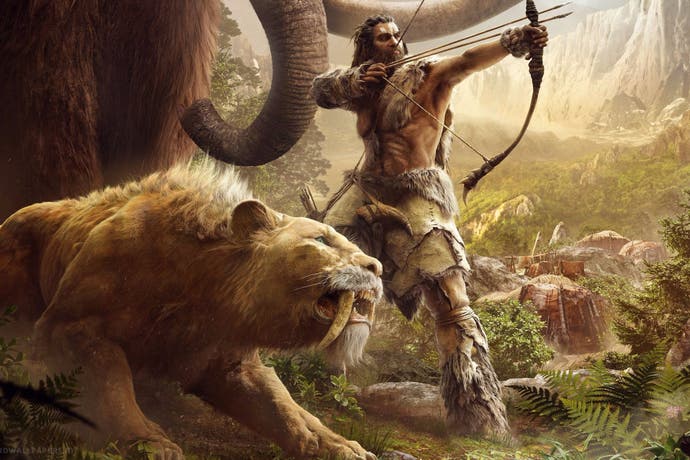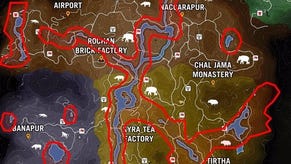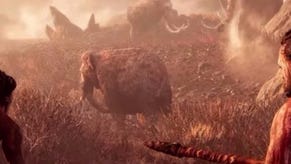Digital Foundry: Hands-on with Far Cry Primal
The new tech Ubisoft adds to its Dunia 2 engine, plus PS4 performance.
Ubisoft Montreal takes Far Cry Primal to the next, natural step: a foggy, Mesolithic land of raw survival, set 12,000 years in humanity's past. As delivered by the team's Dunia 2 technology, it plants us in an era of sabretooth tigers, looming mammoths, and tribal warfare - all bolstered by new animations and upgraded volumetric lighting. The pre-release PlayStation 4 code in analysis here is a step forward from Far Cry 4 in several aspects, but with so much of the template also remaining as-is from last year's entry, is it evolution enough?
We've played three hours into Far Cry Primal so far, letting us glean a few key technical specifics ahead of its February 23rd release. The first is simple; a pixel count shows a full native 1920x1080 image on PS4, as backed by what appears to be Ubisoft's HRAA post-processing (and also a film grain filter). This 'hybrid reconstruction' technique worked brilliantly for the last entry - bringing the benefits of 4x rotated grid super sampling, with a temporal component that also treats flicker on camera movement.
It's an approach that ties in very well with Far Cry Primal's heavy use of flora. There's little in the way of visual noise on swaying trees and grass, for example, while geometric lines run with no obvious jagged edges. As before, the results look great, and based on an earlier Siggraph presentation, this pass is performed on a 1080p frame within around a one milisecond render time. The implementation may have improved since the last game, but as ever results are very accomplished on the sub-pixel elements used so prominently in this series.
As a technology, HRAA had sadly not really taken off in a major way for Ubisoft's other franchises, but we don't see why. It's designed to treat several causes of aliasing at once, while avoiding blurring to key details you might find in certain forms of FXAA. One pitfall is clear though: judging by its use in Primal, this method still has trouble treating fur shaders correctly. As a result, shimmering artifacts are still an issue on animals in movement, or tribal cloaks, in stark contrast with the rest of the game's otherwise well-rounded treatment.
Far Cry Primal also hangs on to the series' other core qualities. The gates to Oros are opened within the first twenty minutes; a land rich in natural detail, letting you roam wherever you choose to hunt, claim territory, and even tame wild beasts. The Dunia 2 engine is comfortably optimised on PS4 to let you charge around without any distractions like pop-in, streaming all textures, shadows and plants with no visible hitches. The only case where this is challenged on our pre-release code is in spots where the player lights bonfires, after which the camera quick-pans across scenery to show terrain changing its level of detail setting. But at a regular running pace, it's a seamless, robust experience on console, as with Far Cry 4.
As a general rule, Ubisoft Montreal doesn't stray too far from the last game in its rendering technologies otherwise; it's safely budgeted to hit 1080p and hold 30 frames per second on PS4. A few visual enhancements are made on console since last year's effort though, especially in its use of lighting. From the first hunting scene, Far Cry Primal flaunts a heavier use of volumetric effects in particular, simulating the way light penetrates fog - becoming thicker the further you look to the distance.
It's a great touch that featured in Far Cry 4 PC's higher settings, while consoles made do with a simpler light shaft effect at the time. Here, we get a full commitment to the effect that really brings to life the density of the jungle, though it isn't as overbearing as the Nvidia-enhanced volumetric lighting of last year's PC release. Backing this up is a great use of post effects effects too, factoring lens flare, bloom and a smart use of depth of field in cut-scenes.
Another area of gain is in the series' animation quality. Each animal prowls the landscape with an authentic swagger, and every move blends smoothly from one to the next. Given beast-hunting is a core focus this time, where it's possible to summon bears, wolves and even baby mammoths to your aid, it makes sense to see real attention paid in this area. Even with HRAA's issues with fur, the turnout is convincing, purely in the way each creature interacts with one another in the wild. Added to that, facial capture looks much improved for the human cast - though short of the photorealistic quality of Assassin's Creed Syndicate.

All of this holds at a near perfect 30fps, with adaptive v-sync engaged. In our testing of this pre-release code, it's unusual to spot any drops at all on PS4, while tearing appears only in the top 10 per cent of the screen when it does. The main instigator is close-ups on animals, particularly in scripted cut-scenes - but even then the worst stat on record is 28fps. It's an anomaly found in the very first segment, and otherwise the game is very keenly optimised to hold at an unwavering 30fps.
The determination to keep Far Cry Primal's technical make-up on PS4 similar to last year's entry is a sign of how other versions might turn out. Though we haven't spotted Xbox One in play yet, it's very plausible we'll see a return of the lower 1440x1080 framebuffer used in Far Cry 4. Given parity between the two consoles in all other graphical settings, this divide in resolution gave Xbox One some issues in image quality back then, with its own variation of HRAA not fully able to disguise its shortcoming in pixel density - and leaving a softer image overall.
We hope this area can be touched on for the Xbox One release when it arrives, though PS4 owners have little to worry about here. Meanwhile, the PC release is an interesting proposition; Far Cry 4 was worth the extra wait for its added tessellation on trees and volumetric lighting modes. A similar suite of extras should be in the running for Far Cry Primal on PC, but based on this console test, the game is already in great shape on the visual front.
The outlook is positive on PS4 then; despite a sparing few upgrades over the last game, Far Cry Primal's chosen refinements attack the areas needed to push its new setting. As signifier of the console experience, it'll be interesting to see where Ubisoft Montreal takes the Xbox One version too, and whether the engine's new tricks extend fully to both current-gen machines. To answer that, we'll be back with the full breakdown nearer its late February release.










